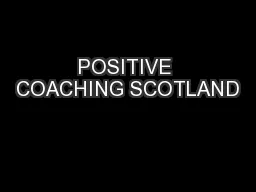PPT-Coaching the Female Athlete
Author : briana-ranney | Published Date : 2018-02-26
2 Key themes Are there differences between male and female athletes Coaching the Female AthleteTeam What sways females to play sport the model of influence Coaches
Presentation Embed Code
Download Presentation
Download Presentation The PPT/PDF document "Coaching the Female Athlete" is the property of its rightful owner. Permission is granted to download and print the materials on this website for personal, non-commercial use only, and to display it on your personal computer provided you do not modify the materials and that you retain all copyright notices contained in the materials. By downloading content from our website, you accept the terms of this agreement.
Coaching the Female Athlete: Transcript
Download Rules Of Document
"Coaching the Female Athlete"The content belongs to its owner. You may download and print it for personal use, without modification, and keep all copyright notices. By downloading, you agree to these terms.
Related Documents














